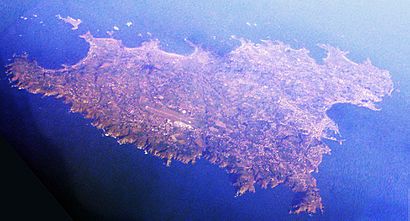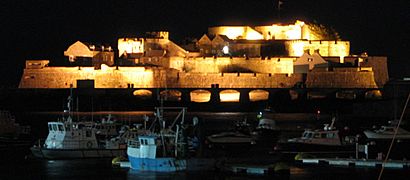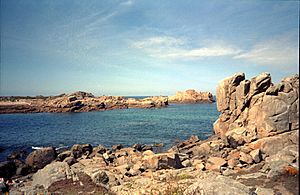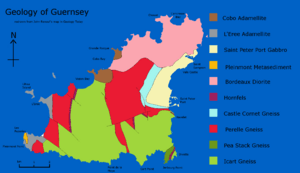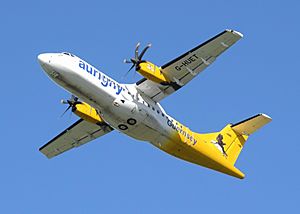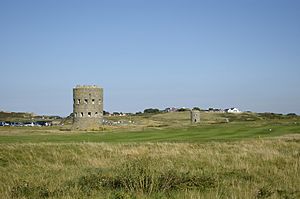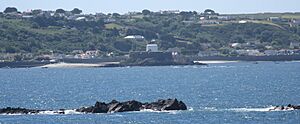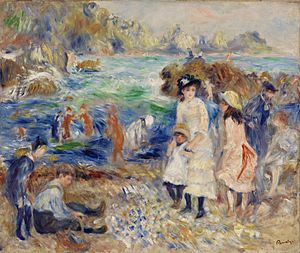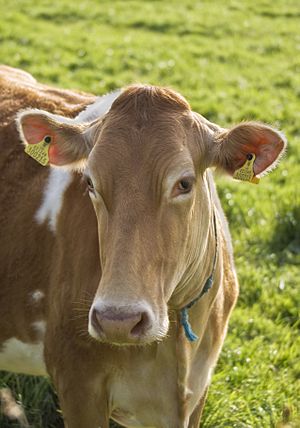Guernsey facts for kids
Quick facts for kids
Guernsey
|
|||
|---|---|---|---|
|
|||
| Anthem: "Sarnia Cherie" | |||
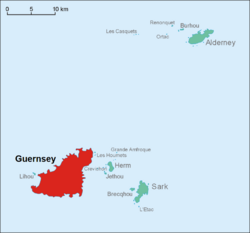
Map of Guernsey within the Bailiwick
|
|||
| Sovereign state | United Kingdom | ||
| Crown Dependency | Bailiwick of Guernsey | ||
| Separation from the Duchy of Normandy | 1204 | ||
| Capital and largest city
|
Saint Peter Port 49°27′36″N 2°32′7″W / 49.46000°N 2.53528°W |
||
| Official languages | |||
| Recognised regional languages | |||
| Ethnic groups | |||
| Demonym(s) |
|
||
| Government | Parliamentary constitutional monarchy | ||
| Charles III | |||
| Richard Cripwell | |||
|
• Bailiff
|
Sir Richard McMahon | ||
|
• Chief Minister
|
Lyndon Trott | ||
| Legislature | States of Guernsey | ||
| Area | |||
|
• Total
|
62 km2 (24 sq mi) | ||
|
• Water (%)
|
0 | ||
| Population | |||
|
• 2022 census
|
63,950 (207th) | ||
|
• Density
|
965/km2 (2,499.3/sq mi) | ||
| GDP (PPP) | 2018 estimate | ||
|
• Total
|
£3.272 billion | ||
|
• Per capita
|
£52,531 | ||
| Currency | Guernsey pound Pound sterling (£) (GBP) |
||
| Time zone | UTC+00:00 (GMT) | ||
|
• Summer (DST)
|
UTC+01:00 (BST) | ||
| Date format | dd/mm/yyyy | ||
| Driving side | left | ||
| Calling code | +44 | ||
| UK postcode |
GY1–GY8
|
||
| ISO 3166 code | GG | ||
| Internet TLD | .gg | ||
Guernsey (![]() i/ˈɡɜːrnzi/ GURN-zee; Guernésiais: Guernési; French: Guernesey) is the second-largest island in the Channel Islands, located 27 miles (43 km) west of the Cotentin Peninsula, Normandy. It is the largest island in the Bailiwick of Guernsey, which includes five other inhabited islands (Alderney, Herm, Jethou, Lihou, and Sark) and many small islets and rocks. The Bailiwick has a population of 63,950, the vast majority of whom live on Guernsey, and the island has a land area of 24 square miles (62 km2).
i/ˈɡɜːrnzi/ GURN-zee; Guernésiais: Guernési; French: Guernesey) is the second-largest island in the Channel Islands, located 27 miles (43 km) west of the Cotentin Peninsula, Normandy. It is the largest island in the Bailiwick of Guernsey, which includes five other inhabited islands (Alderney, Herm, Jethou, Lihou, and Sark) and many small islets and rocks. The Bailiwick has a population of 63,950, the vast majority of whom live on Guernsey, and the island has a land area of 24 square miles (62 km2).
Guernsey was part of the Duchy of Normandy until 1204, when the Channel Islands remained loyal to the English crown, splitting from mainland Normandy. In 1290, the Channel Islands were divided administratively and Guernsey became part of the Bailiwick of Guernsey. During the Second World War, Guernsey was invaded and occupied by Nazi Germany. After five years of occupation, the island was liberated on 9 May 1945, which is celebrated annually as Liberation Day.
Guernsey is administered as part of the Bailiwick of Guernsey, a self-governing dependency of the British Crown. The island is thus not part of the United Kingdom, although the UK government has certain responsibilities for the Bailiwick. The British monarch is the head of state and the head of government is the President of the Policy and Resources Committee. The jurisdiction's parliament and government is the States of Guernsey. The island is divided into ten parishes. It has one town called Saint Peter Port. The government variously defines the position of the King of England as "Head of State" or "successor to the Duke of Normandy. Although no document explicitly defines the Head of State as a "monarch", or the islands as a monarchy, all documents refer to the King by royal titles.
Guernsey's largest industry is financial services, followed by tourism and agriculture. The island is particularly well-known for its cattle. Guernsey's culture is strongly influenced by Britain, evident in its use of the pound sterling and the status of English as the primary native language. Norman and French culture also have an impact, such as the island's traditional language, Guernésiais. In addition, French writer Victor Hugo spent fifteen years in exile in Guernsey, where he wrote some of his best-known works.
Toponymy
The island's name, "Guernsey", like that of neighbouring "Jersey", is of Old Norse origin. The second element of each word, "-ey", is the Old Norse for "island", while the original root, "guern(s)", is of uncertain origin and meaning, possibly deriving from either a personal name such as Grani or Warinn, or from gron, meaning pine tree.
Previous names for the Channel Islands vary over history, but include the Lenur islands, and Sarnia; Sarnia for Guernsey, or Lisia (Guernsey) and Angia (Jersey).
History
Etymology
The name "Guernsey", as well as that of neighbouring "Jersey", is of Old Norse origin. The second element of each word, "-ey", is the Old Norse for "island", while the original root, "guern(s)", is of uncertain origin and meaning. (It could be from the latinification of the word "Kvern", or "mill", in old and new Icelandic and Norwegian, meaning "mill-island")
Early history
Around 6000 BC, rising seas created the English Channel and separated the Norman promontories that became the bailiwicks of Guernsey and Jersey from continental Europe. Neolithic farmers then settled on its coast and built the dolmens and menhirs found in the islands today.
During their migration to Brittany, Britons occupied the Lenur islands (the former name of the Channel Islands) including Sarnia or Lisia (Guernsey) and Angia (Jersey). Travelling from the Kingdom of Gwent, Saint Sampson, later the abbot of Dol in Brittany, is credited with the introduction of Christianity to Guernsey.
In 933 AD, the Cotentin Peninsula including Avranchin which included the islands, were placed by the French King Ranulf under the control of William I. The island of Guernsey and the other Channel Islands represent the last remnants of the medieval Duchy of Normandy.
During the Middle Ages, the island was a haven for pirates that would use the "lamping technique" to ground ships close to her waters. This intensified during the Hundred Years War, when, starting in 1339, the island was occupied by the Capetians on several occasions. The Guernsey Militia was operational in 1337 and would help defend the island for a further 600 years.
In 1372, the island was invaded by Aragonese mercenaries under the command of Owain Lawgoch (remembered as Yvon de Galles), who was in the pay of the French king. Owain and his dark-haired mercenaries were later absorbed into Guernsey legend as invading fairies from across the sea.
Early modern history
In the mid-16th century, the island was influenced by Calvinist reformers from Normandy. During the Marian persecutions, three women, the Guernsey Martyrs, were burned at the stake for their Protestant beliefs.
During the English Civil War, Guernsey sided with the Parliamentarians. The allegiance was not total, however; there were a few Royalist uprisings in the southwest of the island, while Castle Cornet was occupied by the Governor, Sir Peter Osborne, and Royalist troops. In December 1651, with full honours of war, Castle Cornet surrendered; it was the last Royalist outpost anywhere in the British Isles to surrender.
Wars against France and Spain during the 17th and 18th centuries gave Guernsey shipowners and sea captains the opportunity to exploit the island's proximity to mainland Europe by applying for letters of marque and turning their merchantmen into privateers.
By the beginning of the 18th century, Guernsey's residents were starting to settle in North America. The threat of invasion by Napoleon prompted many defensive structures to be built at the end of that century. The 19th century saw a dramatic increase in the prosperity of the island, due to its success in the global maritime trade, and the rise of the stone industry.
20th century
During the First World War, about 3,000 island men served in the British Expeditionary Force. Of these, about 1,000 served in the Royal Guernsey Light Infantry regiment formed from the Royal Guernsey Militia in 1916.
For most of the Second World War, the Channel Islands were occupied by German troops. Before the occupation, 80% of Guernsey children had been evacuated to England to live with relatives or strangers during the war. Some children were never reunited with their families. The occupying German forces deported over 1,000 Guernsey residents to camps in southern Germany, notably to the Lager Lindele (Lindele Camp) near Biberach an der Riß and to Laufen. Guernsey was very heavily fortified during World War II, out of all proportion to the island's strategic value. Life for the civilians on the island was very difficult, especially after June 1944 when the island was under siege. German defences remain a lasting reminder of those times.
During the late 1940s the island repaired the damage caused to its buildings during the occupation. The tomato industry started up again and thrived until the 1970s when it hit a sharp, terminal decline. Tourism has remained important. Finance businesses grew in the 1970s and expanded in the next two decades and are important employers.
Geography
Situated around 49°35′N 2°20′W / 49.583°N 2.333°W, Guernsey, Herm and some other smaller islands together have a total area of 71 square kilometres (27 sq mi) and coastlines of about 46 kilometres (29 mi). Elevation varies from sea level to 110 m (360 ft) at Hautnez on Guernsey.
There are many smaller islands, islets, rocks and reefs in Guernsey waters. Combined with a tidal range of 10 metres (33 feet) and fast currents of up to 12 knots, this makes sailing in local waters dangerous.
The island of Guernsey has a population of around 63,000 in 24 square miles (62 km2) and forms the legal and administrative centre of the jurisdiction of Guernsey and the shopping and service centre for all three jurisdictions. The parliament of the whole jurisdiction of Guernsey, including the nearby inhabited islands of Herm, Jethou and Lihou, plus the neighbouring jurisdiction of Alderney is the States of Guernsey.
Climate
Guernsey's climate is temperate with mild winters and warm, sunny summers. The warmest months are July and August, when temperatures are generally around 20 °C (68 °F) with some days occasionally going above 24 °C (75 °F). On average, the coldest month is February with an average weekly mean air temperature of 6 °C (42.8 °F). Average weekly mean air temperature reaches 16 °C (60.8 °F) in August. Snow rarely falls and is unlikely to settle, but is most likely to fall in February. The temperature rarely drops below freezing, although strong wind-chill from Arctic winds can sometimes make it feel like it. The rainiest months are December (average 112 mm (4.4 in)), November (average 104 mm (4.09 in)) and January (average 92 mm (3.62 in)). July is, on average, the sunniest month with 250 hours recorded sunshine; December the least with 58 hours recorded sunshine. 50% of the days are overcast.
A number of records were set in 2014. It was the highest annual mean temperature of 12.4 °C (54.3 °F). This is 0.3 °C (32.5 °F) higher than for any other year, due to an almost complete absence of cold snaps during the winter months. Three very wet months meant that the winter was the wettest on record. Halloween turned out to be warmer than any other on record, with the temperature peaking at 18.3 °C (64.9 °F).
| Climate data for Guernsey (1981-2010 normals) | |||||||||||||
|---|---|---|---|---|---|---|---|---|---|---|---|---|---|
| Month | Jan | Feb | Mar | Apr | May | Jun | Jul | Aug | Sep | Oct | Nov | Dec | Year |
| Record high °C (°F) | 15.0 (59.0) |
14.6 (58.3) |
18.6 (65.5) |
24.3 (75.7) |
26.0 (78.8) |
31.0 (87.8) |
32.6 (90.7) |
34.3 (93.7) |
27.0 (80.6) |
23.6 (74.5) |
18.0 (64.4) |
17.3 (63.1) |
34.3 (93.7) |
| Mean daily maximum °C (°F) | 8.7 (47.7) |
8.4 (47.1) |
10.0 (50.0) |
11.8 (53.2) |
14.9 (58.8) |
17.5 (63.5) |
19.5 (67.1) |
19.8 (67.6) |
18.0 (64.4) |
15.1 (59.2) |
11.8 (53.2) |
9.5 (49.1) |
13.8 (56.8) |
| Daily mean °C (°F) | 6.9 (44.4) |
6.5 (43.7) |
7.8 (46.0) |
9.2 (48.6) |
12.1 (53.8) |
14.5 (58.1) |
16.6 (61.9) |
17.0 (62.6) |
15.5 (59.9) |
13.0 (55.4) |
10.0 (50.0) |
7.8 (46.0) |
11.4 (52.5) |
| Mean daily minimum °C (°F) | 5.0 (41.0) |
4.6 (40.3) |
5.6 (42.1) |
6.6 (43.9) |
9.2 (48.6) |
11.5 (52.7) |
13.6 (56.5) |
14.1 (57.4) |
12.9 (55.2) |
10.8 (51.4) |
8.1 (46.6) |
6.0 (42.8) |
9.0 (48.2) |
| Record low °C (°F) | −7.4 (18.7) |
−7.3 (18.9) |
−5.5 (22.1) |
−1.0 (30.2) |
0.0 (32.0) |
5.8 (42.4) |
8.8 (47.8) |
8.9 (48.0) |
7.0 (44.6) |
2.3 (36.1) |
−0.8 (30.6) |
−3.3 (26.1) |
−7.4 (18.7) |
| Average precipitation mm (inches) | 92.5 (3.64) |
70.2 (2.76) |
67.0 (2.64) |
53.1 (2.09) |
50.9 (2.00) |
45.5 (1.79) |
42.1 (1.66) |
47.7 (1.88) |
57.5 (2.26) |
95.0 (3.74) |
104.3 (4.11) |
112.9 (4.44) |
838.7 (33.02) |
| Average precipitation days (≥ 0.2 mm) | 19.3 | 15.7 | 15.9 | 13.2 | 11.9 | 10.4 | 11.0 | 10.6 | 12.4 | 17.3 | 18.8 | 18.6 | 175.0 |
| Average snowy days | 2.8 | 4.0 | 1.3 | 0.6 | 0.0 | 0.0 | 0.0 | 0.0 | 0.0 | 0.0 | 0.5 | 1.7 | 11.0 |
| Mean monthly sunshine hours | 61.0 | 85.6 | 127.6 | 194.7 | 234.5 | 246.6 | 250.7 | 230.1 | 180.1 | 117.1 | 77.8 | 58.2 | 1,864 |
| Source 1: Guernsey Met Office 2014 Weather Report | |||||||||||||
| Source 2: Météo Climat | |||||||||||||
Geology
Guernsey has a geological history stretching further back into the past than most of Europe. There is a broad geological division between the north and south of the Island. The Southern Metamorphic Complex is elevated above the geologically younger, lower lying Northern Igneous Complex. Guernsey has experienced a complex geological evolution (especially the rocks of the southern complex) with multiple phases of intrusion and deformation recognisable.
Economy
Financial services, such as banking, fund management, and insurance, account for about 37% of GDP. Tourism, manufacturing, and horticulture, mainly tomatoes and cut flowers, especially freesias, have been declining. Light tax and death duties make Guernsey a popular offshore finance centre for private-equity funds.
Guernsey does not have a Central Bank and it issues its own sterling coinage and banknotes. UK coinage and (English, Scottish and Northern Irish-faced) banknotes also circulate freely and interchangeably. Total island investment funds, used to fund pensions and future island costs, amount to £2.7billion as at June 2016. The island issued a 30-year bond in December 2015 for £330m, its first bond in 80 years. The island has been given a credit rating of AA-/A-1+ with a stable outlook from Standard & Poor's.
Guernsey has the official ISO 3166-1 alpha-2 code GG and the official ISO 3166-1 alpha-3 code GGY; market data vendors, such as Reuters, will report products related to Guernsey using the alpha-3 code.
In March 2016 there were over 32,291 people employed in Guernsey with 4,864 being self-employed and 2,453 employing businesses. 19.6% worked in the finance industry and median earnings were £31,215.
Infrastructure
Public services, such as water, wastewater, the two main harbours and the airport are still owned and controlled by the States of Guernsey.
Electricity, and postal services have been commercialised and are now operated by companies Guernsey Electricity and Guernsey Post which are wholly owned by the States of Guernsey.
Gas is supplied by an independent private company.
In 1998, Guernsey and Jersey jointly formed the Channel Islands Electricity Grid to operate and manage the submarine cables between Europe and the Channel Islands. The installation of these cables was originally to provide the island with a secure form of backup power but now are effectively the primary source of power with the local diesel generators providing back-up.
Guernsey Telecoms, which provided telecommunications, was sold by the States to Cable & Wireless plc, rebranded as Sure and was sold to Batel co in April 2013. Newtel was the first alternative telecommunications company on the island and was acquired by Wave Telecom in 2010 and subsequently rebranded as Jersey Telecom. Airtel-Vodafone also provide a mobile network.
Both the Guernsey Post postal boxes (since 1969) and the telephone boxes (since 2002) are painted blue, but otherwise are identical to their British counterparts, the red pillar box and red telephone box. In 2009 the telephone boxes at the bus station were painted yellow just like they used to be when Guernsey Telecoms was state-owned. The oldest pillar box still in use in the British Isles can be found in Union Street, St Peter Port, and dates back to 1853.
Transport
The primary mode of transport on the island is the motor vehicle. Guernsey has an extensive network of lanes, some of which are distinguished as green lanes under the name 'Ruette Tranquille', translated to 'quiet street'. Pedestrians, cyclists, and horse riders have priority with the speed limit on these lanes at 15 mph.
Ports exist in St Peter Port and St Sampson, and there is also an airport in Forest. These are operated by Guernsey Ports.
The States of Guernsey wholly own their own airline, Aurigny. The decision to purchase the airline was made to protect important air links to and from the island and the sale was completed on 15 May 2003.
Guernsey has a public bus service, operated by CT Plus under the name 'buses.gg', owned by Kelsian Group on behalf of the States of Guernsey Environment and Infrastructure Department. There is also a taxi network and an electronic bike scheme (EVie), which also operates in Jersey.
Business
As of 2014[update], the finance industry forms the largest economic sector in Guernsey, generating around 40% of Guernsey's GDP and directly employing around 21% of its workforce. Banks began setting up operations in the island from the early 1960s onwards in order to avoid high onshore taxes and restrictive regulation. The industry regulator is the Guernsey Financial Services Commission, which was established in 1987. In 2015, the Bailiwick of Guernsey (in conjunction with Jersey) established the Channel Islands Financial Ombudsman (CIFO) to resolve consumer complaints about financial services provided in or from the Channel Islands of Jersey, Guernsey, Alderney and Sark.
Prior to the growth of the finance industry, the island's main industries were quarrying and horticulture. The latter particularly declined as a result of the oil-price shocks of the 1970s and the introduction of cheap North Sea gas that benefited Dutch growers. Guernsey is home to Specsavers Optical Group, and Healthspan also has its headquarters in Guernsey.
Tourism
Guernsey has been a tourist destination since at least the Victorian days, with the first tourist guide published in 1834. In the 19th century, two rail companies (London and South Western Railway and Great Western Railway) ran competing boats from the UK to St Peter Port, with a race to the only convenient berth. This was halted with the sinking of the SS Stella in 1899.
Guernsey enters Britain in Bloom with St Martin Parish winning the small town category twice in 2006 and 2011, Saint Peter Port winning the large coastal category in 2014 and St Peter's winning the small coastal prize in 2015. Herm has won Britain in Bloom categories several times: in 2002, 2008, and 2012, Herm won the Britain in Bloom Gold Award.
The military history of the island has left a number of fortifications, including Castle Cornet, Fort Grey, Guernsey loophole towers and a large collection of German fortifications with a number of museums.
The use of the roadstead in front of St Peter Port by over 100 cruise ships a year is bringing over 100,000 day-trip passengers to the island each year.
Taxation
Guernsey, Alderney and Sark each raise their own taxation, although in 1949 Alderney (but not Sark) transferred its fiscal rights to Guernsey.
Personal tax liability differs according to whether an individual is resident in the island or not. Individuals resident in the Jurisdiction of Guernsey (which does not include Sark) pay income tax at the rate of 20% on their worldwide income, whereas non-residents are only liable on income arising from activity or ownership within Guernsey. The income tax year in Guernsey aligns to the calendar year. All Guernsey-resident individuals are subject to an upper limit on their tax liability, which is known as the "tax cap". Individuals may elect either of the following; Tax on non-Guernsey-source income originally restricted to £110,000, plus tax on Guernsey-source income (excluding Guernsey bank interest), or Taxed on worldwide income originally restricted to £220,000, including Guernsey-source income. Income derived from Guernsey land and property is excluded from the tax cap, as from 1 January 2015, and is subject to tax at the normal rate of 20%. Only one cap applies per married couple. As from 1 January 2019, these tax caps have increased to £130,000 and £260,000 respectively. Guernsey has also introduced a new lower £50k tax cap for new residents for three years, subject to buying an Open Market Part A house with a document duty in excess of that amount, and not having lived in Guernsey or Alderney for three years prior.
Since 2008, Guernsey has operated three levels of corporation tax, depending on the source of the income.
- A 0% corporation tax rate on most companies.
- A 10% rate (income from banking business and, with effect from 1 January 2013, extended to domestic insurance business, fiduciary business, insurance intermediary business and insurance manager business).
- A 20% rate (income from trading activities regulated by the Office of the Director General of Utility Regulation, and income from the ownership of lands and buildings).
Guernsey levies no capital gains, inheritance, capital transfer, value added (VAT / TVA) or general withholding taxes. Guernsey has thus been described a tax haven. In the 2011 Budget, the UK announced that it would be ending Low Value Consignment Relief that was being used to sell goods VAT free to customers across the UK, with this legislation coming into force on 1 April 2012. Tax revenues represent 22.4% of GDP.
Social Insurance Scheme payments are based on gross earnings and apply to all persons over school leaving age. Employees are subject to a rate of 6.8%, whilst the self-employed pay 11.3%. Both have upper and lower earnings limits. Those classed as non-employed and under pension age pay a rate of 10.7%. Other categories have different rates.
Society
Demographics
The population is 63,026 (July 2016 est.) The median age for males is 40 years and for females is 42 years. The population growth rate is 0.775% with 9.62 births/1,000 population, 8 deaths/1,000 population, and annual net migration of 6.07/1,000 population. The life expectancy is 80.1 years for males and 84.5 years for females. The Bailiwick ranked 10th in the world in 2015 with an average life expectancy of 82.47 years.
Structure of the population
| Age Group | Male | Female | Total | % |
|---|---|---|---|---|
| Total | 31 381 | 32 067 | 63 448 | 100 |
| 0–4 | 1 403 | 1 295 | 2 698 | 4.25 |
| 5–9 | 1 692 | 1 602 | 3 294 | 5.19 |
| 10–14 | 1 723 | 1 581 | 3 304 | 5.21 |
| 15–19 | 1 620 | 1 512 | 3 132 | 4.94 |
| 20–24 | 1 866 | 1 778 | 3 644 | 5.74 |
| 25–29 | 1 976 | 1 869 | 3 845 | 6.06 |
| 30–34 | 2 080 | 2 052 | 4 132 | 6.51 |
| 35–39 | 2 033 | 1 902 | 3 935 | 6.20 |
| 40–44 | 1 913 | 1 987 | 3 900 | 6.15 |
| 45–49 | 2 095 | 2 212 | 4 307 | 6.79 |
| 50–54 | 2 378 | 2 601 | 4 979 | 7.85 |
| 55–59 | 2 467 | 2 494 | 4 961 | 7.82 |
| 60–64 | 2 059 | 2 172 | 4 231 | 6.67 |
| 65-69 | 1 763 | 1 729 | 3 492 | 5.50 |
| 70-74 | 1 730 | 1 882 | 3 612 | 5.69 |
| 75-79 | 1 095 | 1 211 | 2 306 | 3.63 |
| 80-84 | 858 | 1 030 | 1 888 | 2.98 |
| 85-89 | 419 | 687 | 1 106 | 1.74 |
| 90-94 | 172 | 347 | 519 | 0.82 |
| 95+ | 39 | 124 | 163 | 0.26 |
| Age group | Male | Female | Total | Per cent |
| 0–14 | 4 818 | 4 478 | 9 296 | 14.65 |
| 15–64 | 20 487 | 20 579 | 41 066 | 64.72 |
| 65+ | 6 076 | 7 010 | 13 086 | 20.62 |
Border control
The whole jurisdiction of Guernsey is part of the Common Travel Area.
For immigration and nationality purposes it is UK law, and not Guernsey law, which applies (technically the Immigration Act 1971, extended to Guernsey by Order in Council). Guernsey may not apply different immigration controls from the UK. After the United Kingdom left the European Union, from 1 January 2021 all EU nationals, other than British or Irish nationals, travelling for anything other than visitor purposes, are required to apply for a visa to enter the UK, Bailiwick of Guernsey, Jersey or the Isle of Man, prior to travel. People coming for employment to Guernsey require a Visa and a Population Management document.
Housing restrictions
Guernsey undertakes a population management mechanism using restrictions over who may work in the island through control of which properties people may live in. The housing market is split between "local market" properties and a set number of "open market" properties. Anyone may live in an open market property, but local market properties can only be lived in by those who qualify – either through being born in Guernsey (to at least one local parent), by obtaining a housing licence, or by virtue of sharing a property with someone who does qualify (living en famille). Consequently, "open market'" properties are much more expensive both to buy and to rent. Housing licences are for fixed periods, often only valid for 4 years and only as long as the individual remains employed by a specified Guernsey employer. The licence will specify the type of accommodation and be specific to the address the person lives in, and is often subject to a police record check. These restrictions apply equally regardless of whether the property is owned or rented, and only apply to occupation of the property. Thus, a person whose housing licence expires may continue to own a Guernsey property, but will no longer be able to live in it. There are no restrictions on who may own a property.
There are a number of routes to qualifying as a "local" for housing purposes. Generally, it is sufficient to be born to at least one Guernsey parent and to live in the island for ten years in a twenty-year period. In a similar way a partner (married or otherwise) of a local can acquire local status. Multiple problems arise following early separation of couples, especially if they have young children or if a local partner dies; in these situations, personal circumstances and compassion can add weight to requests for local status. Once "local" status has been achieved it remains in place for life. Even a lengthy period of residence outside Guernsey does not invalidate "local" housing status.
Although Guernsey's inhabitants are full British citizens, prior to the UK's withdrawal from the EU, an endorsement restricted the right of establishment in other European Union states was placed in the passport of British citizens connected solely with the Channel Islands and Isle of Man. If it was classified with "Islander Status", the British passport was endorsed as follows: 'The holder is not entitled to benefit from EU provisions relating to employment or establishment'. Those who had a parent or grandparent born in the United Kingdom itself (England, Scotland, Wales and Northern Ireland), or had lived in the United Kingdom for 5 years, were not subject to this restriction.
Education
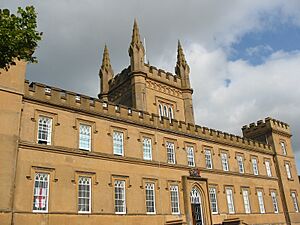
Teaching in Guernsey is based on the English National Curriculum. There are 10 primary schools, plus two junior schools and three infant schools. As of 2022[update], the island no longer has the 11-plus exam, which was used to transfer pupils to one of four 11–16 secondary schools, or a co-educational grammar school. There are also three fee-paying colleges with lower schools, for which pupils over 11 receive grant support from the States of Guernsey. In 2016, the States of Guernsey voted to end the use of the 11-plus exams from 2019 onwards. It is also responsible for education on the neighbouring islands.
In 2008, the school-leaving age was raised so the earliest date is the last Friday in June in the year a pupil turns 16, in line with England, Wales and Northern Ireland. This means pupils will be between 15 and 10 months and 16 and 10 months before being able to leave. Prior to this, pupils could leave school at the end of the term in which they turned 14, if they so wished: a letter was required to be sent to the Education department to confirm this. However, this option was undertaken by relatively few pupils, the majority choosing to complete their GCSEs and then either begin employment or continue their education.
Post-GCSE pupils have a choice of transferring to the state-run Grammar School & Sixth Form Centre, or to the independent colleges for academic AS/A Levels/International Baccalureate Diploma Programme. They also have the option to study vocational subjects at the island's Guernsey College of Further Education.
There are no universities in the island. Students who attend university in the United Kingdom receive state support towards both maintenance and tuition fees. In 2007, the Education Department received the approval of the States Assembly to introduce student contributions to the costs of higher education, in the form of student loans, as apply in the UK. However, immediately after the general election of 2008, the States Assembly voted in favour of a Requête which proposed abolishing the student loans scheme on the grounds that it was expensive to run and would potentially discourage students from going to, and then returning to the island from, university. In 2012, the Education Department reported to the States Assembly that it had no need to re-examine the basis of higher education funding at the present time.
Culture
The French impressionist painter Pierre-Auguste Renoir visited the island in late summer 1883. While on the island, he painted fifteen pictures of the views on the island, all featuring the bay and beach of Moulin Huet on the south coast.
Guernsey cattle are an internationally famous icon of the island. As well as being prized for its rich creamy milk, which is claimed to hold health benefits over milk from other breeds, Guernsey cattle are increasingly being raised for their distinctively flavoured and rich yellowy-fatted beef, with butter made from the milk of Guernsey cows also has a distinctive yellow colour. Since the 1960s the number of individual islanders raising these cattle for private supply has diminished significantly, but Guernsey steers can still be occasionally seen grazing on L'Ancresse common.
Guernsey also hosts a breed of goat known as the Golden Guernsey, distinguished by its golden-coloured coat. At the end of the Second World War, the Golden Guernsey had almost been rendered extinct due to interbreeding on the island. The survival of this breed is largely credited to the work of a single woman, Miriam Milbourne, who successfully hid her herd from the Germans during the occupation. Although no longer considered to be critically endangered, the breed remains on the watchlist of the Rare Breeds Survival Trust. The traditional explanation for the donkey (âne in French and Guernésiais) is the steepness of St Peter Port streets that necessitated beasts of burden for transport (in contrast to the flat terrain of the rival capital of Saint Helier in Jersey), although it is also used in reference to Guernsey inhabitants' stubbornness. In turn, Guernseymen traditionally refer to Jerseymen as crapauds ("toads").
The so-called Guernsey lily, Nerine sarniensis, is also used as a symbol of the island, although this species was introduced to the island from South Africa.
Local food
A local delicacy is the ormer (Haliotis tuberculata), a variety of abalone harvested under strict laws from beaches at low spring tides. Traditional Guernsey recipes include a stew called Guernsey bean jar, notably served at the annual Viaer Marchi festival. Its chief ingredients include haricot and butter beans, pork, and shin beef. Guernsey gâche (pronounced "gosh") is a special bread made with raisins, sultanas and mixed peel. Gâche mélée is a dessert consisting of spiced, chopped apples suspended in a sponge mix.
Languages
English is the language in general use by the majority of the population, while Guernésiais, the Norman language of the island, is spoken fluently by only about 2% of the population (according to 2001 census). However, 14% of the population claim some understanding of the language. Until the early 20th century, French was the only official language of the Bailiwick, and all deeds for the sale and purchase of real estate in Guernsey were written in French until 1971. Family and place names reflect this linguistic heritage. George Métivier, a poet, wrote in Guernésiais. The loss of the island's language and the Anglicisation of its culture, which began in the 19th century and proceeded inexorably for a century, accelerated sharply when the majority of the island's school children were evacuated to the UK for five years during the German occupation of 1940–45.
Literature
Victor Hugo, having arrived on Halloween 1855, wrote some of his best-known works while in exile in Guernsey, including Les Misérables. His home in St Peter Port, Hauteville House, is now a museum administered by the city of Paris. In 1866, he published a novel set on Guernsey, Travailleurs de la Mer (Toilers of the Sea), which he dedicated to the island. Guernsey was his home for fifteen years.
Mabel Collins (1851–1927), a theosophist and prolific author, was born in St Peter Port.
Guernseyman G. B. Edwards wrote a critically acclaimed novel, The Book of Ebenezer Le Page, that was published in 1981, including insights into Guernsey life during the 20th century. In September 2008, a blue plaque was affixed to the house on the Braye Road where Edwards was raised.
Henry Watson Fowler moved to Guernsey in 1903. He and his brother Francis George Fowler composed The King's English, the Concise Oxford Dictionary and much of Modern English Usage on the island.
The Guernsey Literary and Potato Peel Pie Society, a novel by Mary Ann Shaffer and Annie Barrows, describes the Occupation of Germans during World War II. Written in 2009, it is about a writer who begins corresponding with residents of the island, and becomes compelled to visit the island.
Film
A film adaptation of The Guernsey Literary and Potato Peel Pie Society, starring Lily James and Jessica Brown Findlay, was released in 2018.
The 2022 British psychological thriller film Marooned Awakening, starring Murray McArthur, Tilly Keeper and Tim McInnerny was co-written by and stars Guernseyman, Cameron Ashplant. Ashplant produced the film through Across the Channel Productions Ltd, alongside London-based director Musaab Mustafa, and Guernsey co-producers Frances and Roger Le Tissier of Ivy Gate Films. Principal photography was completed entirely on Guernsey in September 2021. The film premiered on the island at Beau Séjour Theatre on 3 September 2022.
Media
Local TV coverage is provided by BBC Channel Islands and ITV Channel Television. There are three relay transmitters in Guernsey (St Peter Port, Les Touillets and Torteval) which are transmitted from the Fremont Point transmitter.
Guernsey has two radio stations: BBC Radio Guernsey on 93.2 FM and Island FM on 104.7 FM which both broadcast from St. Peter Port.
The main local newspaper for the island is served by the Guernsey Press.
Sport
Guernsey participates in the biennial Island Games, which it hosted in 1987 and 2003 at Footes Lane. Guernsey has also participated as a country in its own right in Commonwealth Games since 1970. Its first medals came in 1982 with its first gold in 1990.
In those sporting events where Guernsey does not have international representation, but the British Home Nations are competing separately, highly skilled islanders may choose to compete for any of the Home Nations. There are, however, restrictions on subsequent transfers to represent other Home Nations. The football player Matt Le Tissier, for example, could have played for the Scottish or Welsh football teams, but opted to play for England instead.
Football in Guernsey is run by the Guernsey Football Association. The top tier of Guernsey football is the FNB Priaulx League where there are eight teams (Alderney, Belgrave Wanderers, Northerners, Sylvans, St Martin's, Rovers, Rangers and Vale Recreation). The second tier is the Jackson League. In the 2011–12 season, Guernsey F.C. was formed and entered the Combined Counties League Division 1, becoming the first Channel Island club ever to compete in the English leagues. Guernsey became division champions comfortably on 24 March 2012, they won the Combined Counties Premier Challenge Cup on 4 May 2012. Their second season saw them promoted again on the final day in front of 1,754 'Green Lions' fans, this time to Division One South of the Isthmian League, despite their fixtures being heavily affected not only by poor winter weather, but by their notable progression to the semi-finals of the FA Vase cup competition. They play in level 8 of the English football pyramid. The Corbet Football Field, donated by Jurat Wilfred Corbet in 1932, has fostered the sport greatly over the years. Recently, the island upgraded to a larger, better-quality stadium, in Footes Lane.
Guernsey has the second oldest tennis club in the world, at Kings (founded in 1857), with courts built in 1875. The island has produced a world class tennis player in Heather Watson as well as professional squash players in Martine Le Moignan, Lisa Opie and Chris Simpson.
Guernsey was declared an affiliate member by the International Cricket Council (ICC) in 2005 and an associate member in 2008. The Guernsey cricket team plays in the World Cricket League and European Cricket Championship as well as the Sussex Cricket League.
Various forms of motorsport take place on the island, including races on the sands on Vazon beach as well as a quarter-mile "sprint" along the Vazon coast road. Le Val des Terres, a steeply winding road rising south from St Peter Port to Fort George, is often the focus of both local and international hill-climb races. The 2005, 2006 and 2007 World Touring Car Champion Andy Priaulx is a Guernseyman.
The racecourse on L'Ancresse Common was re-established in 2004 after a gap of 13 years, with the first new race occurring on 2 May 2005. Races are held on most May Day bank holidays, with competitors from Guernsey as well as Jersey, France and the UK participating. Sea angling around Guernsey and the other islands in the Bailiwick from shore or boat is a popular pastime for both locals and visitors with the Bailiwick boasting multiple UK records.
See also
 In Spanish: Guernsey para niños
In Spanish: Guernsey para niños




